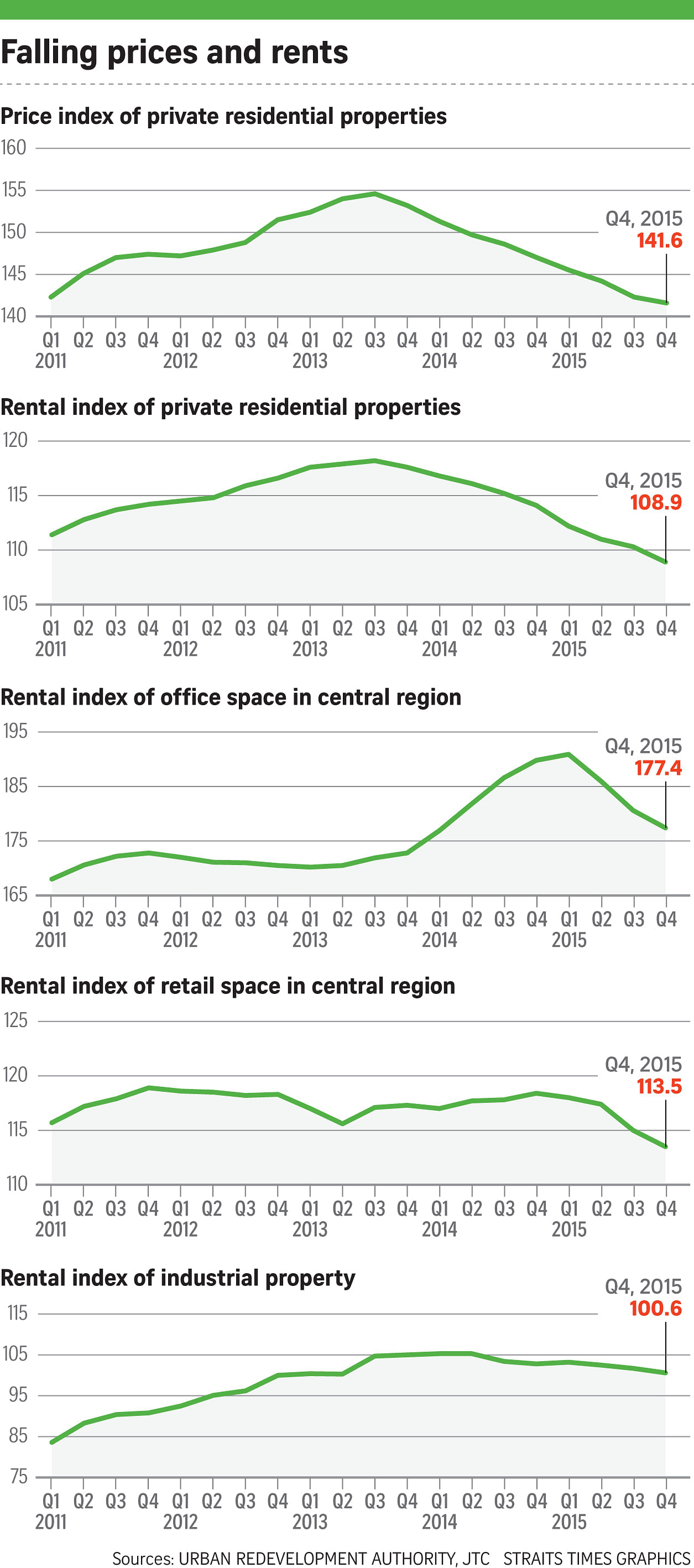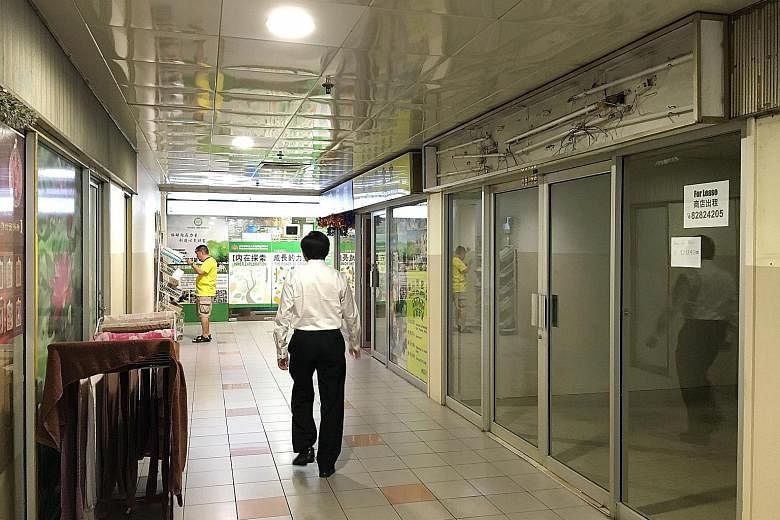Over at Paya Lebar Square, which was completed late in 2014, only around half the offices are occupied.
Back in 2012, when the project was launched, these strata office units - units that can be held by individual owners - were snapped up in no time at all.
Paya Lebar Square was far and away the top-selling project in the strata office sector that year as property investors piled into the non- residential property market.
Rents, when the centre was completed late in 2014, started at $6.50 to $7 per sq ft (psf) per month, but the good times did not last long.
Today, rents are less than $4 psf. Of the 556 offices, about 50 per cent are occupied.
"Many people bought more than one unit. Given that most of the units were sold at $1,650 to $2,000 psf, (at current rents), rental yield is quite bad," said real-estate agent Kaushik Bhanushali.
Be it offices, industrial buildings or shops, any project that was launched in those years was practically bound to sell like hot cakes.
It is a similar story at Alexandra Central mall next to Ikea. The mall was completed in late 2014. Almost all the 116 shops were sold in one day when it was launched in 2013 with more than 150 interested buyers submitting blank cheques to participate in a ballot for one shop unit on the third storey. Fast forward three years and crowds are thin now. There were 14 of the 31 shops on the first floor up for sale or lease when The Straits Times visited on Tuesday.
-
REAL ESTATE SERVICES
-
Share of GDP (nominal value added) in 2015:
About 4.8 per cent Sector employment at Sept 2015: 89,900
Growth: Contracted 1.5 per cent last year, after declining 2.0 per cent in 2014
"I thought the crowd would be better. They were marketing the mall like an Orchard Road (prime district) equivalent," said the owner of a Japanese cafe there, whose takings cannot cover the $7,000 monthly rent for his 450 sq ft space.
Now, transactions have slowed and launches have dried up.
In retrospect, cooling measures to prevent investors from over-extending themselves and to curb speculation have probably helped to cushion the downside in the current slowdown.
Even long-established player People's Park Centre is feeling the crunch. Shops there have closed, even in the basement, where the popular eateries are.
A year ago, there were no vacancies. Retailers say business has slowed dramatically.
"It got quiet towards the end of last year. After Chinese New Year, business is even worse," said Ms Esther Chua, who runs a second-hand designer-bag shop on the first floor.
Sales over the past year have fallen by about 70 per cent, she estimated. "The crowds are fewer and people are just not out to shop."
If small-business owners are the first to feel the pinch, landlords and developers of retail and commercial property are surely next, at the same time that the residential market weakens as well.
Among the large-office landlords, distributable income inched up 0.8 per cent to $64.13 million at CapitaLand Commercial Trust for the fourth quarter ended Dec 31. Keppel Reit also managed a rise in distribution per unit for the fourth quarter but said market conditions are expected to remain difficult.
On the ground, property agents like Mr H.H. Tan, who has been in the industry for 17 years, are feeling the pain.
The value of properties he sold in 2014 was 30 per cent lower than in the good times of 2013, and 60 to 70 per cent lower last year.
He started marketing foreign property in the middle of last year when the market here "really nosedived".
"The commission I collect is less as the quantum level of foreign properties is not as high, although developers normally try to give a higher commission rate to make up for that. Still, I'm earning 50 per cent of what I was earning in 2013," he said.
He is also looking at other sources of income, perhaps renovating landed properties.
Agents have also been bailing out of the industry. The number of registered agents fell from 31,783 at the start of 2014 to 30,830 last year and 29,262 this year.
But there is more inactivity than suggested by these numbers.
At ERA Realty, for example, only about 60 per cent of its 6,100 agents are actively recording transactions.
Rents have been declining as well and at a faster pace, putting more pressure on investors already facing higher interest rates.
They fell 26 per cent in the core central region from June 2013 to January this year, were down 4.1 per cent in the city fringes and 6.6 per cent lower in the suburbs, according to Savills.

Yet the rental market has not quite felt the weight of multiple retrenchments in the finance and oil and gas or commodities sectors, which began in earnest from the fourth quarter of last year.
"Any retrenchment benefits or payouts they had may tide them through two to three quarters post-layoff," said Mr Alan Cheong, Savills Singapore research head. "The question is: How much reserves do they have before they run dry?"
There is, therefore, increasing risk that people stop paying their mortgages. For now, mortgagee sale listings have risen, but not alarmingly. They shot up 51.6 per cent to 241 last year and could exceed 270 this year - the amount recorded during the 2008 global financial crisis - according to Colliers International.
But this would still be far lower than the 2,462 mortgagee sale listings that occurred during the market downturn in 2004 and 452 listings during the 1998 Asian financial crisis, noted Ms Grace Ng, deputy managing director at Colliers.
Ms Ng feels that the numbers will not spike as the employment rate is generally still high.
The problems in retail are being mirrored in the commercial and industrial property sectors, where capital values and rents are sliding.
Industrial property prices eased 1.7 per cent last year after rising for four straight years, while rents fell 2.1 per cent, the second straight year of decline.
"There is huge supply, and demand is low, made worse by the slowing economy," said Mr Lim Kien Kim, the head of industrial services at Colliers.
"For us, the comforting thing is that there are enquiries, but this is based on need, as in need to consolidate or to look for cheaper rents.
"In terms of new businesses or demand for space? Barely. We are all looking for the demand drivers right now. This is something we are struggling to identify."
Trying to work out when the gloom will end is a question that is taxing pretty much everyone in the industry.
As Century 21 chief executive Ku Swee Yong said: "We can probably only make a guess when there are signs of key sectors that contribute to GDP and employment - manufacturing, trade, finance - show signs of reaching a bottom. But that doesn't seem to be happening."



